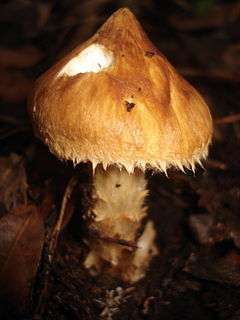Squamanita
Squamanita is a parasitic genus of agaric fungi[6] formerly classified in the family Tricholomataceae[7][8] and is now in the Cystodermateae in the Squamanitaceae.[9] The fruitbodies of this genus resemble a normal agaric but they emerge from parasitized fruitbodies of other agarics that Squamanita has deformed. The deformation may be massive and the host may then resemble a lump, or the deformation may be so subtle that the Squamanita appears to be grafted onto the stipe of the host that nearly always fails to form a pileus. Because of the seamless graft-like attachment or the severe deformation of the host into a nonrecognizable blob, early descriptions[4][7][8] included features of the host in descriptions of Squamanita as if they were parts of the parasite.[6] This error led to the creation of a separate subgenus[4] because of misinterpretation of host veil tissue as part of the parasite and ultimately a separate genus, Dissoderma.[5] Serendipitous discovery of one parasitized host fruitbody (Galerina) that formed its own pileus that then bore three Squamanita contortipes fruitbodies revealed the parasitic nature of the relationship for that species and the entire genus.[6] This discovery was so shocking that it was featured in Nature magazine under the title 'Mycological mystery tour'.[10] Once the parasitic nature was revealed, the term 'protocarpic tuber' used by earlier authors[7][8] for the parasitized host base was replaced by the term 'cecidiocarp'[11] or 'cecidiocarpo'[12] in Spanish.
| Squamanita | |
|---|---|
 | |
| Squamanita umbonata | |
| Scientific classification | |
| Kingdom: | |
| Division: | |
| Class: | |
| Order: | |
| Family: | |
| Genus: | Squamanita Imbach (1946)[1] |
| Type species | |
| Squamanita schreieri Imbach (1946) | |
| Synonyms[2] | |
Since 1994 other investigative research on finds of this rare genus of mushrooms has shown that Squaminta odorata is a parasite of Hebeloma mesophaeum,[13] Squamanita paradoxa parasitizes Cystoderma amianthinum,[9] and Squamanita umbonata parasitizes Inocybe oblectabilis.[14]
Like some other mycoparasitic agaric parasites (e.g. Asterophora, Collybia, and Dendrocollybia) of other agarics, some Squamanita species also form resistant structures that would permit survival in the absence of the host. These Squamanita form thick-walled chlamydospores on their hosts' fruitbodies.[6][7]
Species
- Squamanita basii – Harmaja 1988
- Squamanita cettoiana – M. M. Moser 1986
- Squamanita citricolor – Thoen 1998
- Squamanita contortipes – (A.H.Sm. & D.E.Stuntz) Heinem. & Thoen 1973[15]
- Squamanita fimbriata – Gulden, Bendiksen & Brandrud 1977
- Squamanita granulifera – Bas & Læssøe 1999
- Squamanita odorata – (Cool) Imbach 1946
- Squamanita paradoxa – (A.H.Sm. & Singer) Bas 1965
- Squamanita pearsonii – Bas 1965
- Squamanita schreieri – Imbach 1946
- Squamanita squarrulosa – G.S.Ridl. 1988
- Squamanita umbilicata – Harmaja 1988
- Squamanita umbonata – (Sumst.) Bas 1965
References
- Imbach EJ (1946). "Pilzflora des Kantons Luzern und der angrenzen Innerschweiz". Mitteilungen der naturforschenden Gesellschaft Luzern (in German). 15: 5–85 (see p. 81).
- "Squamanita Imbach 1946". MycoBank. International Mycological Association. Retrieved 2011-12-12.
- Huijsman HSC (1943). "Observations sur le "genre" Lepiota". Mededelingen van de Nederlandse Mycologische Vereeniging (in French). 28: 3–60.
- Smith AH, Singer R. "Notes on the genus Cystoderma". Mycologia. 40 (4): 454–460. doi:10.2307/3755152.
- Singer R. (1973). "Diagnoses fungorum novorum Agaricalium III". Beihefte zur Sydowia. 7: 1–106 (see p. 69).
- Redhead SA, Ammirati JF, Walker GR, Norvell LL, Puccio MB (1994). "Squamanita contortipes, the Rosetta Stone of a mycoparasitic agaric genus". Canadian Journal of Botany. 72 (12): 1812–1824. doi:10.1139/b94-223.
- Bas C. (1965). "The genus Squamanita". Persoonia. 3: 331–359.
- Singer R. (1986). The Agaricales in Modern Taxonomy (4th ed.). Koenigstein Königstein im Taunus, Germany: Koeltz Scientific Books. ISBN 3-87429-254-1.
- Matheny PB, Griffith GW (2010). "Mycoparasitism between Squamanita paradoxa and Cystoderma amianthinum (Cystodermateae, Agaricales)". Mycoscience. 51 (6): 456–461. doi:10.1007/s10267-010-0052-9.
- Gee H. (1995). "Mycological mystery tour". Nature. 375 (6529): 276. doi:10.1038/375276a0.
- Bas C, Thoen D (1998). "Squamanita citricolor, a new species from central Africa". Persoonia. 17 (1): 135–139.
- Cortés-Pérez A, Guzmán G, Ramírez-Guillén F (2014). "Squamanita umbonata (Fungi, Agaricales, Tricholomataceae), primer registro en México". Acta Botanica Mexicana (in Spanish). 108: 105–111.
- Mondiet N, Dubois MP, Sellose MA (2007). "The enigmatic Squamanita odorata (Agaricales, Basidiomycota) is parasitic on Hebeloma mesophaeum". Mycological Research. 111 (5): 599–602. doi:10.1016/j.mycres.2007.03.009. PMID 17509847.
- Vizzini A, Girlanda M (1997). "Squamanita umbonata (Sumst.) Bas, a mycoparasite of Inocybe oblectabilis (Britz.) Sacc.— preliminary note". Allionia. 35: 171–175.
- Heinemann P, Thoen D (1973). "Observations sur le genre Cystoderma". Bulletin de la Société Mycologique de France (in French). 89 (1): 5–34.
External links
- Squamanita in Index Fungorum
- The pouch strangler: Squamanita squarrulosa in Spores, moulds, and fungi. A natural history of mushrooms and other fungi in New Zealand.